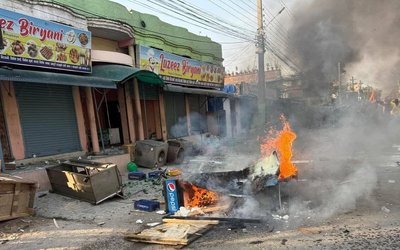
‘EutaSinkoBhachiherda ’ is a collection of published and unpublished articles by Sharu Joshi Shrestha, a development professional and forward thinkerwho has contributed more than two decades of her life working for women and development. First published in 2070 B.S. by MAG Library, the sale proceeds of this book goes to the campaign for ensuring the right to information for women.
Priced at NPR 300 and available at popular bookstores, the book is a memoire of experiences and thoughts of the author, recounting anecdotes and her reflections during the course of her workand travel. Aptly titled 'eutosinkoBachiHerda',which means 'When I Did My Bit', the book leaves readers wanting to do their own bit for their country. And fair enough, the author seems to have done quite a bit from her side.
The articles in the book range through diverse issues pertinent in today’s Nepalese context from migration, gender issues, and social change tomorality,marriages, and life.The author has managed to humanize these issues of national interest and present them in a format that makes for some enjoyable reading, a welcome change from the pedantic style we have become used to and dread even. It befits the title of ‘public intellectual’ bestowed upon her. The colloquial languageand her sharing of personal emotions takes the reader along her journey. You are not reading a book, you are having a conversation with her in your living room.However, beneath all the lighthearted banter that sets the tone in most of the chapters, the readers can feel sharp stab of truth, such as the candid confession of an Indian migrant worker she encounters in Rome, “Didi, our (migrant workers from India and Nepal) problems are the same. After all, we grew up watching the same soap operas”.
The articles are not limited to Nepali issues in isolation, but rather make space for a comparative analysis of the samewith other European and Asian countries. Some of the articles may be a bitter pill to swallow, but that’s how the truth sometimes tastes. ‘Ashobhaniya Kura’,‘Bibhaha’, ‘ChhyamatakoMaapdanda’,‘Ma ta Housewife Hoina Ni’are all reflections of our patriarchal society,the invisible glass ceiling that limitsNepali women and their search for a dignified existence and identity. ‘PurushatwakoParibhasa’makes the reader wonders whether there is a glass ceiling for men as well. Excerpts from various interactions with migrant workers have been assimilated in many of the chapters, bringing to the reader the dreams, tragedies, and resilience ofmigrant workers.The articles on Constitution, politics and nationalism, the national anthem, NRNs, road accident, census, and a South African Driver forces readers to be mindful of the gaps in our own understanding and actions. Lines such as"Kattipaltahaminagarikhaubhanchautaranagarikbandainau, nagarikbhannurabannufarakkurahunn" in 'RastriyataraRajnitikoOverlap'reminds the armchair Nepalese political experts (read us average citizens)to start taking responsibility and become a citizen . Her love, respect for and desire to do more for Nepal and her expectations from the people of Nepal is very apparent in her writing, as this book not only talks about issues and problem, it talks of the changes that have come forthand those that still waiting our actions .‘Ojhel ma ParekoRashtriyaGaan’demanding due respect for our national anthem, reminds us to embrace the changes we have sought and brought forward. She has captured the complexity of the human mind and attitudes in ‘DaibaJanun’, highlighting our fallible optimism in the face of possible dangers- thatmisfortunes only happen to someone else. In her ‘BiralukoGhaatima Ghanti’and ‘BurkabhitrakoStaya’the author has daringly recounted her own personal experiences and taken us through her emotional and mental journeywhen having to make a decision to defy cultural and religiousnorms on the one hand and succumb against her own will to cultural practicesin a foreign country in another. She has balanced her own perspectives on the burkaagainst those of otherNepali women who are actually using it, another example of the unbiased writing and willingness to accept different realities. While reading ‘Doctor Peter koNazarma Nepal’, I too saw Nepal as an amalgamation of 4 centuries from 18th to 21stpeacefully coexisting with one another. Further writings on the culture of thanking, managing old age, coming to terms with death, and first priority family provide the readers with a fresh perspective on these aspects of our generallife. AndI found me wholeheartedly agreeing to the notion of drivers as tourism ambassadors.
One can thoroughly enjoy reading eacharticle in this collection. This book can definitely be called the guide to understanding and developing a new Nepal. Taking us through the Nepal of the 1980sto that of 2014,from peace to conflict to today's Federal Democratic Republic of Nepal, fromour pridesto ourshames in being a Nepali, it givesus suggestions, ideas and hopes for a new Nepal, with criticism and encouragement for one and all Nepalese. Complemented by updated facts and figures, one can get a glimpse of Nepal andits development in a nutshell. However, it would have helped if data sources and time references of published articles were also presented somewhere.It is a book worth reading at least once for all Nepali people from policy makers, parents to homemakers and students - there is something for each one of us. Especially recommendthe youths and the young professionals to not miss out on this one. Even those who find Nepali difficult to read would be pleasantly surprised.
One small tip- does not skip the author's preface, rather read it at the end. It is the icing on the cake, with the author's biography, context and summaries of and responses on various published articles.















